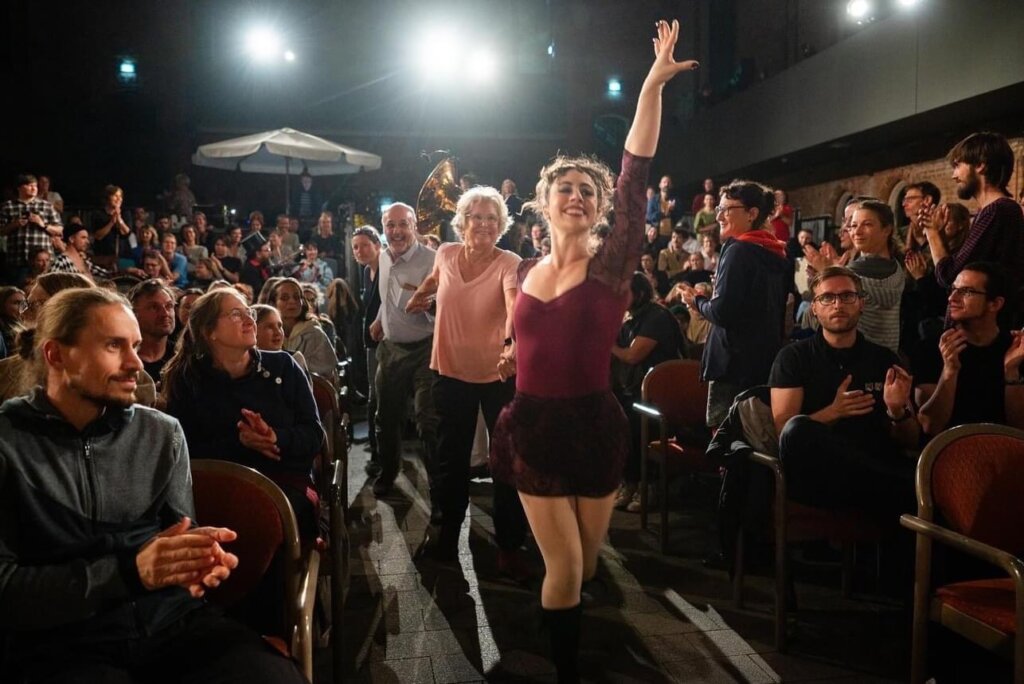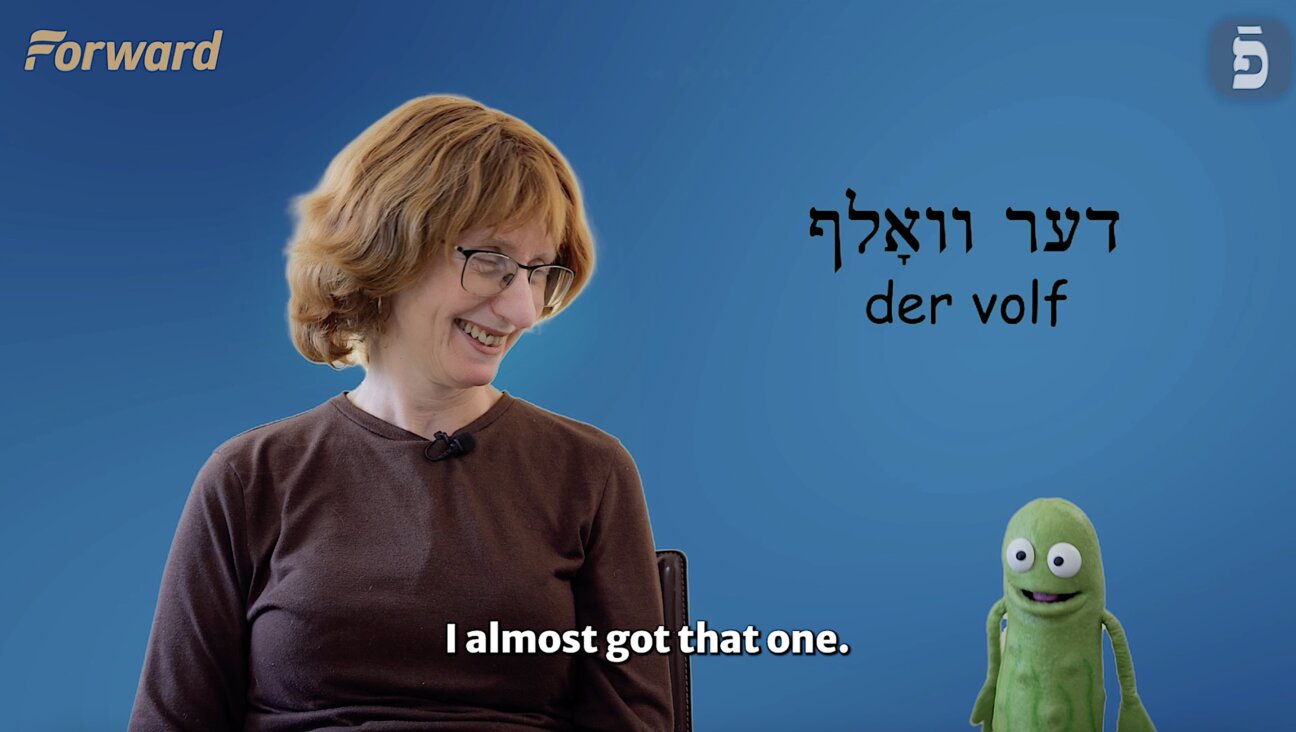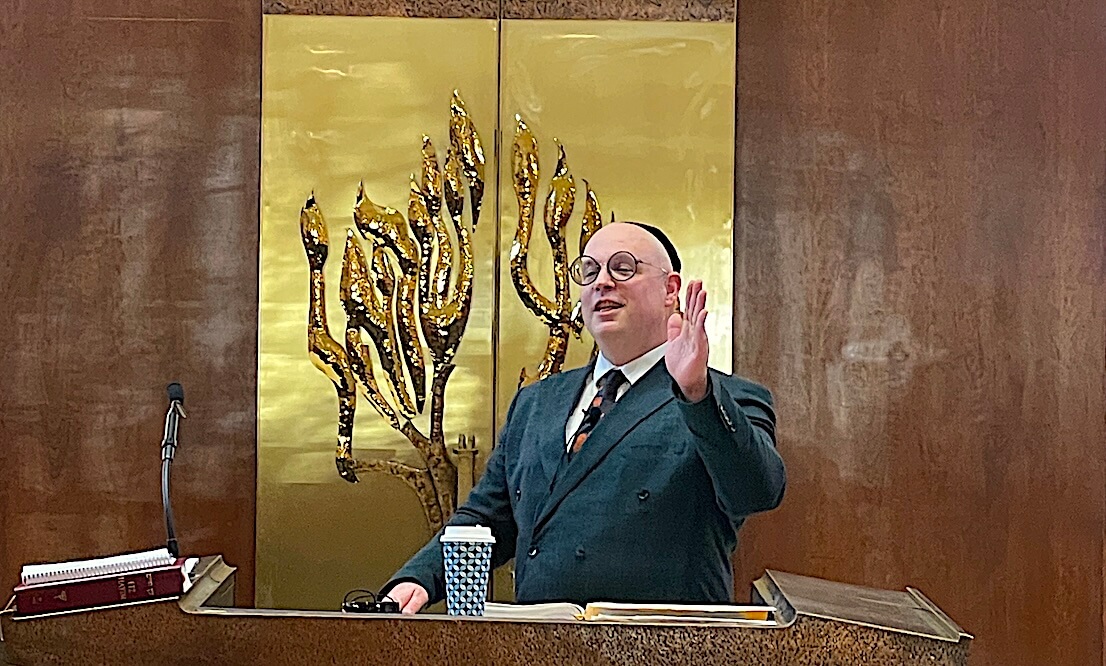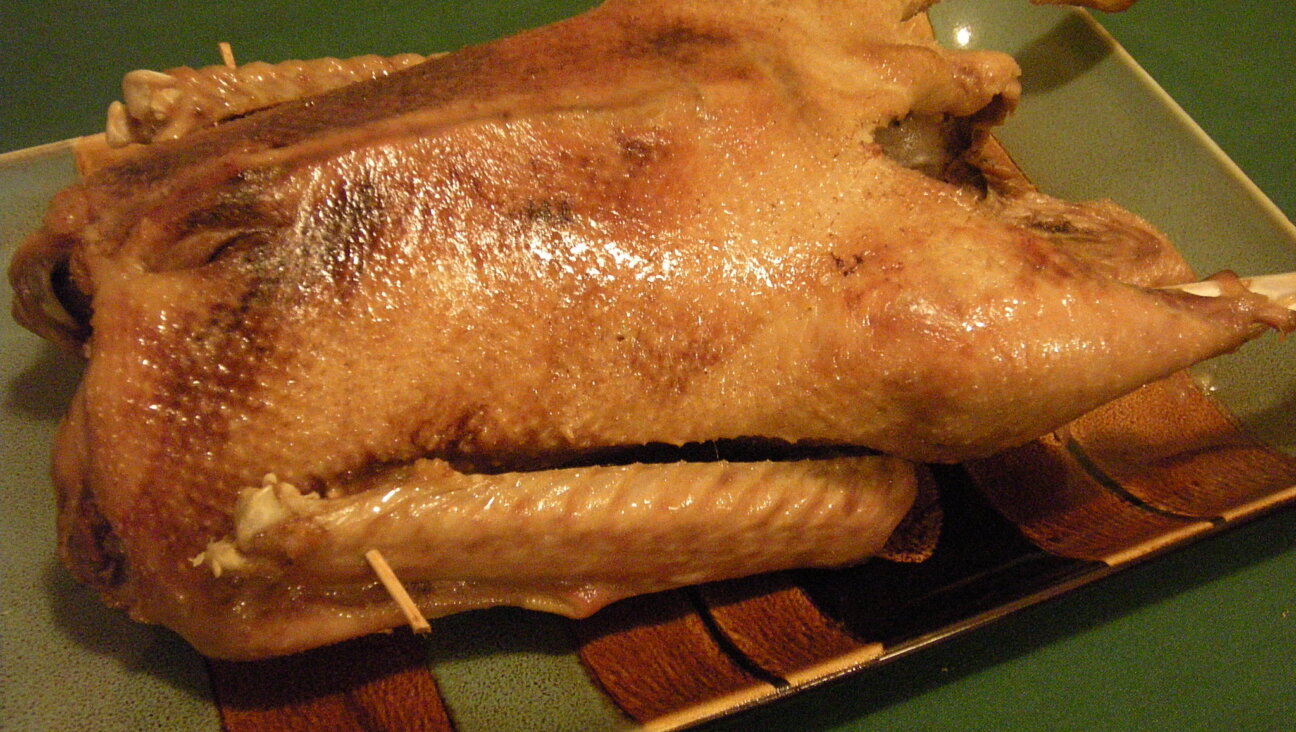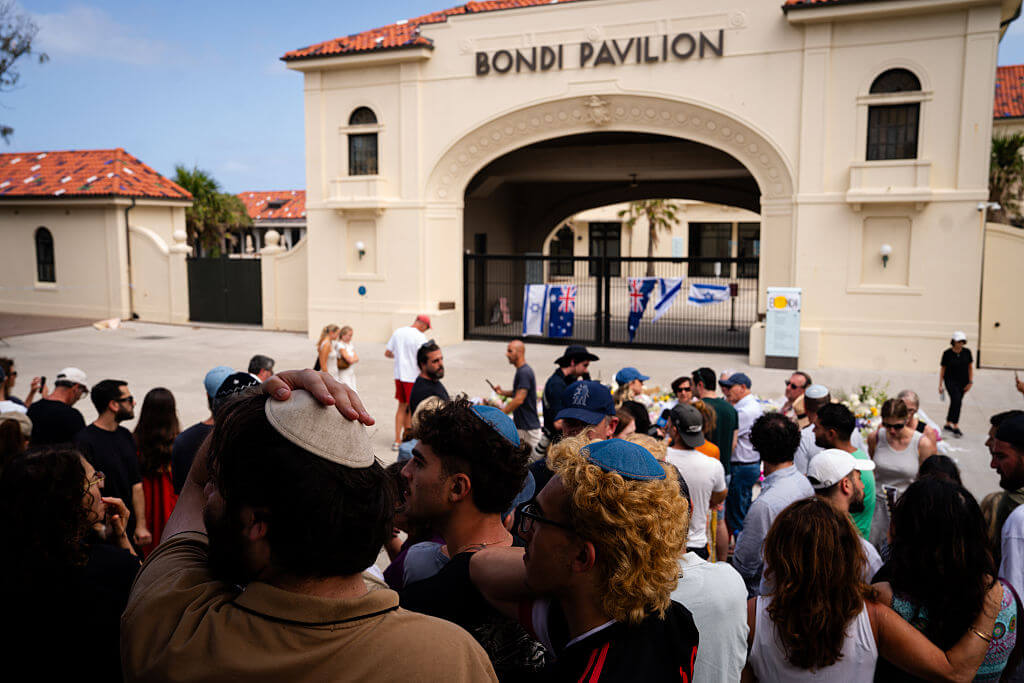A Yiddish circus in a suitcase
German audiences are enthusiastic about the show “Tshemodan,” where circus artists perform to a live klezmer band

Fiddle player Mitia Khramtsov (center) with the band Dobranotch. Photo by Shendl Copitman
Imagine aerial acrobatics accompanied by a dreamy melody on fiddle and cimbalom. A juggler maneuvering seven bouncing balls at once to the beat of a klezmer band. A saxophonist charming a suspiciously human-looking snake with a terkisher (a type of klezmer dance) — and all this interwoven with Yiddish songs and poetic stories of distant hometowns and faded Jewish circus traditions. Above all, suitcases, serving as seats, drums, and, of course, containers for circus equipment.
This is just a glimpse of the show “Tshemodan,” performed by what may be Germany’s first Yiddish circus company, Tsirk Dobranotch. The word tshemodan, Yiddish for “suitcase,” is the company’s second production. The ensemble consists of the klezmer band Dobranotch, joined by circus artists Sam Gurwitt and Eliana Pliskin Jacobs.
Jacobs, an aerialist and singer, has been dreaming of creating a klezmer circus ever since she entered the Yiddish scene in Berlin and other cities in Germany around 2018. In 2022, she met Sam Gurwitt, and they soon realized that they shared not only a background as circus artists but also a connection to the Yiddish and klezmer world: Gurwitt is trained both as a clown and as a klezmer fiddler. Creating a klezmer circus together was the obvious next step.
A few months later, Jacobs, a longtime fan of the band Dobranotch, pitched the idea to its members who have long been known for including comedy and stunts in their musical performances. “We like to do entertainment and eccentric, funny things, and with the circus company we tried to put it on another level,” said Mitia Khramtsov, the band’s fiddle player.
Tsirk Dobranotch’s first show, “Das Fliegende Balagan,” (Yiddishized German for “flying bedlam”) premiered in Dresden in 2023. For their second production, the group decided to incorporate a more coherent “thematic glue,” as Gurwitt calls it, focusing on the theme of migration as reflected in the title “Tshemodan” and to use the suitcase as a recurring element.
Migration — whether voluntary, pressured, or forced – is an experience that runs through all the ensemble members’ family histories or personal biographies. Jacobs and Gurwitt both grew up in the United States as grandchildren of German and Eastern European Holocaust survivors and moved to Germany in their twenties. Dobranotch members Mitia Khramtsov, Germina Gordienko, Ilya Gindin, and Evgenii Lizin are from St. Petersburg and fled to Germany after Russia’s full-scale invasion of Ukraine in 2022. They were joined by Paul Milmeister, who was born in Ukraine and migrated to Germany as a teenager. Some of the Tshemodan shows feature Bertan Canbeldek, an acrobat who was born in Germany to Turkish parents, as a guest artist.
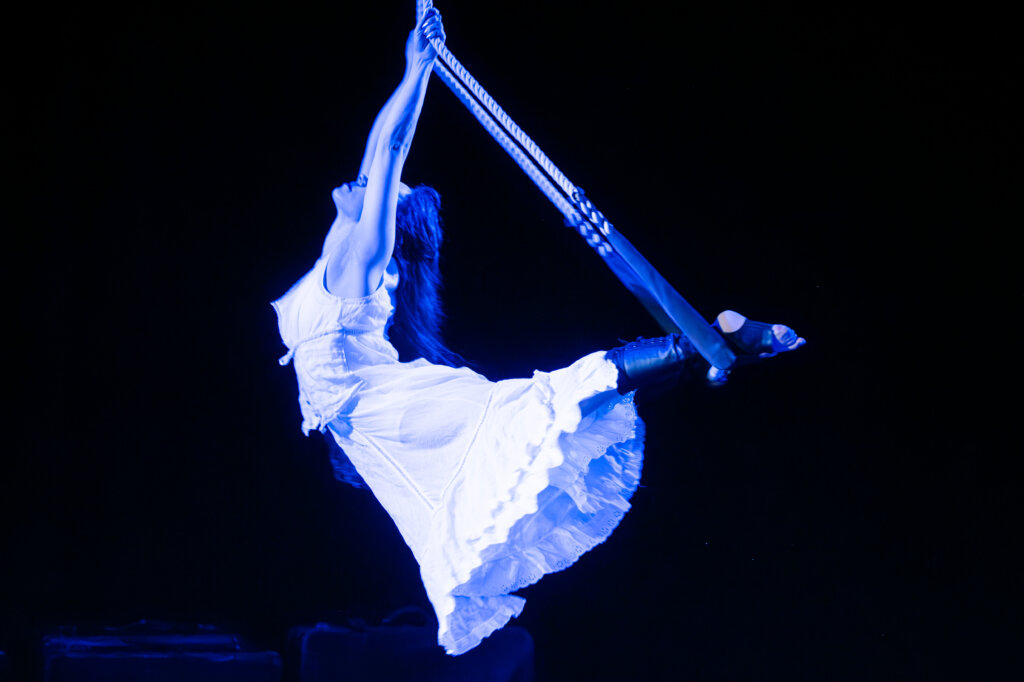
Aside form the overall theme of migration and wandering, the company’s mission is to recall the almost forgotten history of Jewish circuses in pre-Holocaust Europe. In one of Jacobs’s solo acts, she tells the story of Jewish families, among them the Blumenfeld, Lorch, and Straßburger families, who had been running circuses in German-speaking Europe since the 17th century. She then asks herself whether her German-Jewish grandmother might have seen one of the pre-war Jewish circuses.
Comparing herself to “a ghost connecting the living with the dead, the past with the present,” Jacobs swings on a trapeze in a pensive, elegant aerial performance to the delicate sound of a slow hora played by Khramtsov and Gordienko.
Tsirk Dobranotch is aware, however, that these German and Western European Jewish circuses were historically not closely related to Eastern European Yiddish culture or klezmer music. This incongruence makes it difficult to justify why klezmer and circus would go together, Gurwitt admitted. On the other hand, as Jacobs pointed out, “the theme of wandering works well with both circus and klezmer.”
In fact, there is evidence that the klezmer musicians who played at weddings in different shtetls may have been accompanied by jugglers and acrobats. In fact, Khramtsov said, the old tradition of badkhonim (wedding jesters), certainly had historical connections to medieval Jewish jesters known as leytsonim.
While these links between Yiddish culture and the circus world did exist, Jewish culture and religion didn’t play much of a role in the Jewish circuses traveling throughout the German-speaking regions. As Jacobs put it: “They were normal circus performers who happened to be Jewish.”
According to Jacobs and Gurwitt, Jews joining and running important German circuses was evidence of their assimilation into the broader society, even though it eventually failed. Under the Nazi regime, Jewish circus artists were boycotted and persecuted; forced into hiding or exile, and many were eventually murdered.
But there was one circus performer that did not try to hide his Jewish identity. That was Siegmund “Zishe” Breitbart, also called the Iron King and allegedly the “strongest man on Earth.” Born in 1897 and raised in the Yiddish-speaking community of Lodz (at that time part of the Russian Empire), Breitbart overtly expressed his Jewishness on stage. Many of his advertisements and costumes, and even the chariot on which he entered the arena, were adorned with Magen David decorations.
In “Tshemodan,” Gurwitt brings Breitbart’s heroic figure to life by wittily constructing an entire mime act around a muscleman displaying his physical strength. Accompanied by a klezmer march, using only a kitchen towel as a prop, he keeps the audience in laughter and suspense, throwing an imaginary elephant up in the air.
As Tsirk Dobranotch celebrates its third year, it’s clear that audiences have come to love the show, as seen by their cheers and standing ovations. Many audience members even join in the dance leading the troupe offstage after the show.
As the company plans a new show for 2026, their fans can only guess what they’ll continue to unpack from their suitcases.
